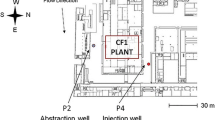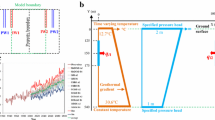Near-subsurface temperatures have signatures of climate change. Thermal models of subsurface have been constructed by prescribing time dependent Dirichlet type boundary condition wherein the temperature at the soil surface is prescribed and depth distribution of temperature is obtained. In this formulation it is not possible to include the relationship between air temperatures and the temperature of soil surface. However, if one uses a Robin type boundary condition, a transfer coefficient relates the air and soil surface temperatures which helps to determine both the temperature at the surface and at depth given near surface air temperatures. This coefficient is a function of meteorological conditions and is readily available. We have developed such a thermal model of near subsurface region which includes both heat conduction and advection due to groundwater flows and have presented numerical results for changes in the temperature–depth profiles for different values of transfer coefficient and groundwater flux. There are significant changes in temperature and depth profiles due to changes in the transfer coefficient and groundwater flux. The analytical model will find applications in the interpretation of the borehole geothermal data to extract both climate and groundwater flow signals.






Similar content being viewed by others
References
Akkiraju V V and Roy S 2011a Geothermal Climate Change Observatory in south India 1: Borehole temperatures and inferred surface temperature histories; Physics and Chemistry of the Earth 36(16) 1419–1427.
Akkiraju V V and Roy S 2011b Geothermal Climate Change Observatory in south India 2: Set-up and first results; Physics and Chemistry of the Earth 36(16) 1428–1436.
Anderson M P 2005 Heat as groundwater tracer; Groundwater 43 951–968.
Bartlett, Marshall G, David S Chapman and Robert N Harris 2006 A decade of ground–air temperature tracking at Emigrant Pass Observatory, Utah; J. Climate 19 3722–3731, doi: 10.1175/JCLI3808.1.
Beltrami H and Kellman L 2003 An examination of short- and long-term air–ground temperature coupling; Global Planet. Change 38 291–303.
Bodri L and Cermak V 2005 Borehole temperatures, climate change and pre-observational surface air temperature mean: Allowances for hydraulic conditions; Global Planet. Change 45 265–276.
Bodri L and Cermak V 2007 Borehole climatology: A new method on how to construct climate; Elsevier, Amsterdam.
Bredehoeft J D and Papadopulos I S 1965 Rates of vertical ground water movement estimated from the Earth’s thermal profile; Water Resour. Res. 1 325–328.
Carslaw H S and Jaeger J C 1959 Conduction of Heat in Solids, 2nd edn (New York: Oxford Univ. Press), 510p.
Constantz J 2008 Heat as a tracer to determine streambed water exchanges; Water Resour. Res. 44 W00D10, doi: 10.1029/2008WR006996.
Davis M G, Chapman D S and Harris R N 2011 Geothermal record of climate change, In: Encyclopedia of Solid Earth Geophysics (ed.) Gupta H K, Springer Science, doi: 10.1007/978-90-481-8702-7.
Davis M G, Harris R N and Chapman D H 2010 Repeat temperature measurements in boreholes from northwestern Utah link ground and air temperature changes at the decadal time scale; J. Geophys. Res. 115 B05203, doi: 10.1029/2009JB006875.
Gonźalez-Rouco J F, Beltrami H, Zorita E and Stevens M B 2009 Borehole climatology: A discussion based on contributions from climate modeling; Clim. Past 5 97–127.
Gunawardhana L N, Kazama S and Kawagoe S 2011 Impact of urbanization and climate change on aquifer thermal regimes; Water Resour. Manag. 25 3247–3276.
Ferguson, Grant, Hugo Beltrami and Allan D Woodbury 2006 Perturbation of ground surface temperature reconstructions by groundwater flow?; Geophys. Res. Lett. 33 L13708.
Heasler H P, George J H and Allen M B 1990 Improved computational schemes for the numerical modeling of hydrothermal resources in Wyoming: Final Report, U.S. Department of Energy.
Kohl T 1998 Paleoclimatic temperature signals – can they be washed out?; Tectonophys. 291 225–234.
Lachenbruch A H and Marshall B V 1986 Changing climate: Geothermal evidence from permafrost in the Alaskan Arctic; Science 234 689–696.
Lubimova I E A, Von Herzen R P and Udintsev G B 1963 On heat transfer through the ocean floor; In: Geophysical monograph series (ed.) Lee W H K, 8 78–86.
Negi J G and Singh R N 1967 On heat transfer in layered oceanic sediments; EPSL 2(4) 335–336.
Pollack H N and Huang S 2000 Climate reconstruction from subsurface temperatures; Ann. Rev. Earth Planet. Sci. 28 339–365.
Putnam S N and Chapman D S 1996 A geothermal climate change observatory: First year results from Emigrant Pass in northwest Utah; J. Geophys. Res. 101 21,877–21,890.
Reiter M 2001 Using precision temperature logs to estimate horizontal and vertical groundwater flow components; Water Resour. Res. 37(3) 663.
Reiter M 2005 Possible ambiguities in subsurface temperature logs – Consideration of groundwater flow and ground surface temperature changes; Pure Appl. Geophys. 162 343–355.
Shan C and Bodvarsson G 2004 An analytical solution for estimating percolation rate by fitting temperature profiles in the vadose zone; J. Contaminant Hydrol. 68 83–95.
Stallman R W 1963 Computation of ground water velocity from temperature data; U.S. Geol. Surv. Water Supply Pap., 1544-H, 36–46.
Stallman R W 1965 Steady one-dimensional fluid flow in a semi-infinite porous medium with sinusoidal surface temperature; J. Geophys. Res. 70 2821–2827.
Stieglitz M and Smerdon J E 2007 Characterizing land–atmosphere coupling and the implications for subsurface thermodynamics; J. Climate 20 21–37; doi: 10.1175/JCLI3982.1.
Swanson T E and Cardenas M B 2011 Ex-stream: A MATLAB program for calculating fluid flux through sediment–water interfaces based on steady and transient temperature profiles; Comput. Geosci. 37 1664–1669.
Taniguchi M 2002 Estimation of the post groundwater recharge rate from deep borehole temperature data; Catena 48 39–51.
Taniguchi M 2011 Groundwater and subsurface environmental assessments under pressure of climate variability and human activities in Asia; In: Groundwater and subsurface environments: Human impacts in Asian coastal cities (ed.) Taniguchi M, Springer, doi: 101007/978-4-431-53904-9_1.
Taniguchi M, Shimada J, Tanala T, Kayane I, Sakura Y, Shimano Y, Dapaah–Siakwan S and Kawashima S 1999a Disturbances of temperature–depth profiles due to surface climate change and surface water flow: 1. An effect of linear increase in surface temperature caused by global warming and urbanization in the Tokyo metropolitan area, Japan; Water Resour. Res. 35(5) 1507–1517.
Taniguchi M, Williamson D R and Peck A J 1999b Disturbances of temperature–depth profiles due to surface climate change and subsurface water flow: 2. An effect of step increase in surface temperature caused by forest clearing in southwest Western Australia; Water. Resour. Res. 35(5) 1519–1529.
Acknowledgements
The authors (RNS and DVR) are grateful to the Director, National Geophysical Research Institute for his kind permission to publish this work. RNS is thankful to INSA for award of a Senior Scientist position. RR is thankful to the Indian Academy of Sciences, Bangalore for providing IASc Summer Fellowship during 2006 when this work was carried out and Director, NGRI for providing supports to work at NGRI. Authors are also grateful to anonymous reviewer for very constructive and helpful suggestions.
Author information
Authors and Affiliations
Corresponding author
Rights and permissions
About this article
Cite this article
KUMAR, R.R., RAMANA, D.V. & SINGH, R.N. Modelling near subsurface temperature with mixed type boundary condition for transient air temperature and vertical groundwater flow. J Earth Syst Sci 121, 1177–1184 (2012). https://doi.org/10.1007/s12040-012-0220-8
Received:
Revised:
Accepted:
Published:
Issue Date:
DOI: https://doi.org/10.1007/s12040-012-0220-8




